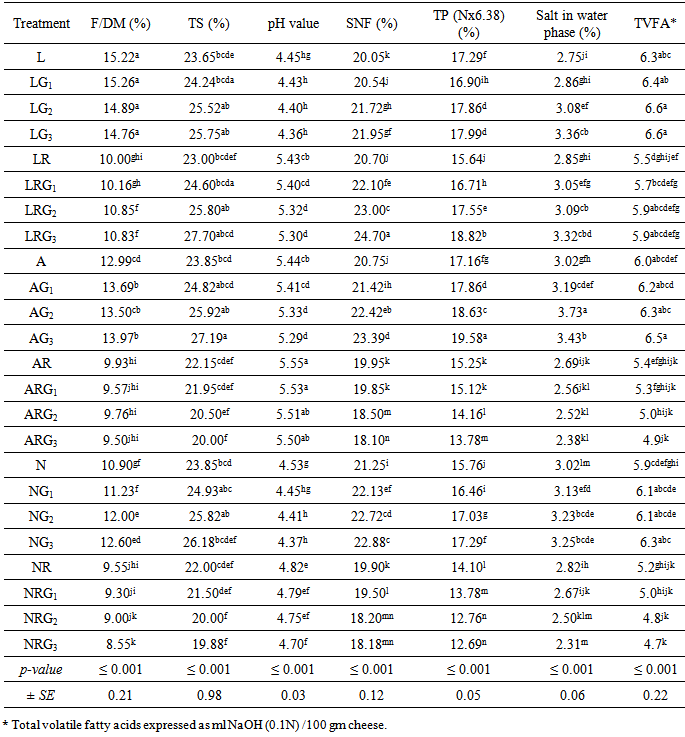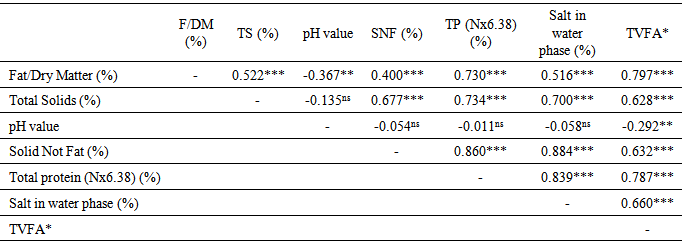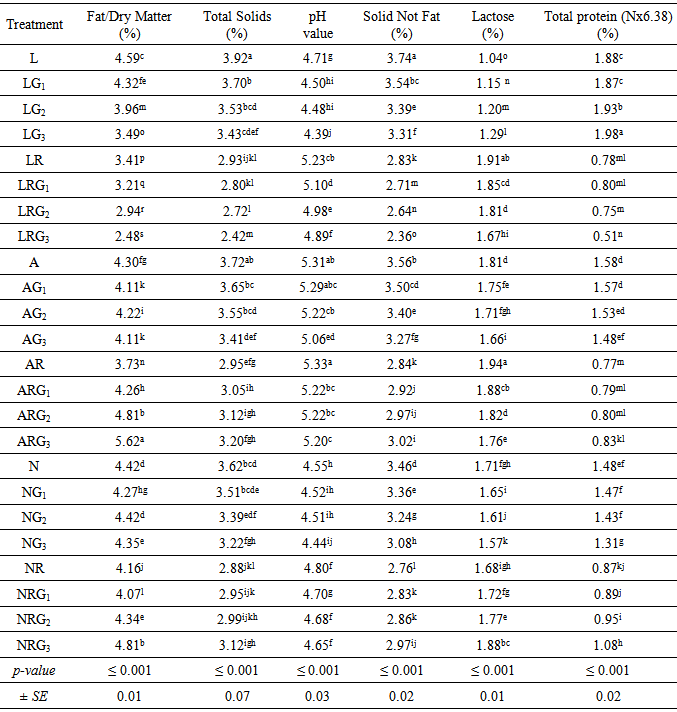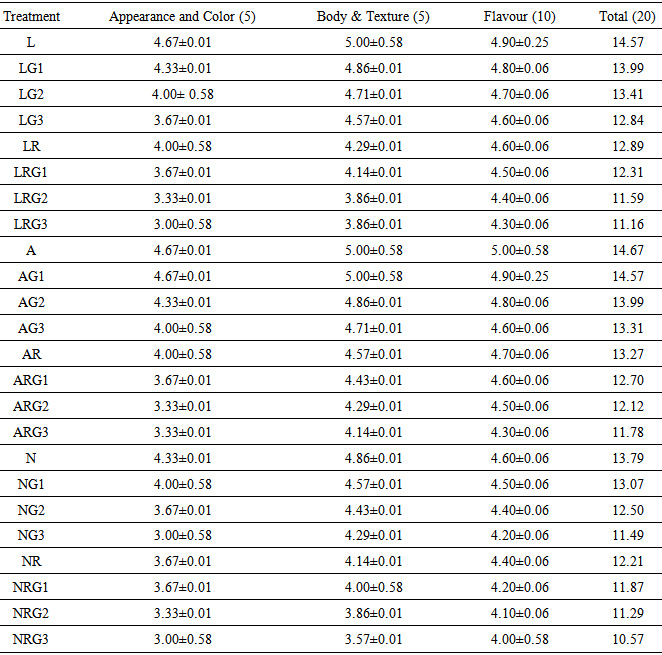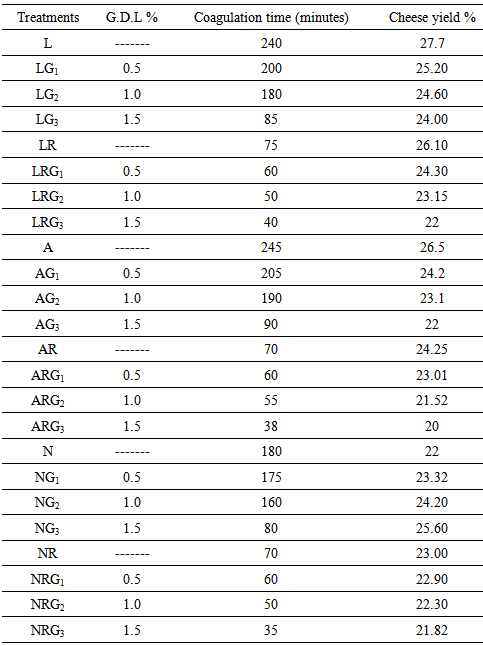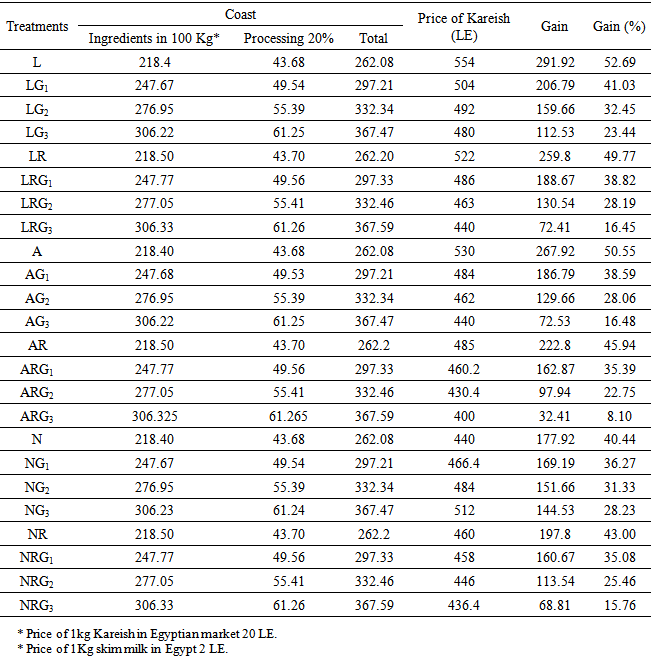| [1] | A. M. Abd-Ehamid, Production of Functional Kariesh Cheese by Microencapsulation of Bifidobacterium adolescentis ATCC 15704. Advance Journal of Food Science and Technology 4 (2): 112-117, 2012. |
| [2] | A. K. Abdel-Razig, The production of white soft cheese from different milk sources. M. Sc. Thesis. University of Khartoum, Sudan, 1996. |
| [3] | K. A. Abdel Razig and Nagla A. A. Babiker, Chemical and Microbiological Properties of Sudanese White Soft Cheese Made by Direct Acidification Technique. Pakistan Journal of Nutrition 8 (8): 1138-1143, 2009. |
| [4] | S. A. I. Abou Dawood, Survival of nonencapsulated and encapsulated Bifidobacterium bifidum in probiotic Kareish cheese. Egypt. Journal of Dairy Science, 30, 43–52, 2002. |
| [5] | S. A. Abou-Donia, Origin, history and manufacturing process of Egyptian dairy products: An overview. Alexandria Journal of Food Science and Technology, 5 (1): 51-62, 2008. |
| [6] | T. K. Ahmed and N. A. Khalifa, The manufacture of white soft cheese (Gibna Beyda) from recombined milk. Sudan Journal of Animal Production, 2: 63-69, 1989. |
| [7] | N. H. Ahmed, M. El-Soda, A. N. Hassan and J. Frank, Improving the textural properties of an acid-coagulated (Karish) cheese using exopolysaccharide producing cultures. LWT-Food Science Technology, 38, 843–847, 2005. |
| [8] | AOAC, Association of official analytical chemists, Official methods of analysis, 19th (Ed), Vol (2), Arlington VA.USA, 2012. |
| [9] | Y. Ardo, Flavour and texture in low fat cheese. In: Law BA (eds) Microbiol. Biochem. of cheese and fermented milk, London, Chapman and Hall, pp. 207-218, 1997. |
| [10] | M. A. A. Azzam and F. M. M. Salama, An attempt to improve the properties and nutritional value of kareish cheese. nnals of Agricultural Science, Moshtohor. 2003; 41(3): 1207-1223, 2003. |
| [11] | P. Beal and G. S. Mittal, Vibration and compression responses of Cheddar cheese at different fat content and age. Milchwissenschaft, 55, 139–142, 2000. |
| [12] | Blassy, I. M. Kholoud and M. M. Ismail, Effect of draining method on the quality of Kareish Cheese. Journal of Agriculture Science, Mansoura Univ., 28 (10): 7365-7374, 2003. |
| [13] | F. Bodyfelt and D. Potter, Creamed cottage cheese. In: Clark, S., Costello, M., Drake, M., Bodyfelt, F. (Eds.), The Sensory Evaluation of Dairy Products, second Ed. Springer Science Business Media, LLC, New York, USA, pp. 167–190, 2009. |
| [14] | J. C. Brooks, B. Martinez, J. Stratton, A. Bianchini, R. Krokstrom and R. Hutkins, Survey of raw milk cheeses for microbiological quality and prevalence of foodborne pathogens. Food Microbiology. 31 (2) 154-158, 2012. |
| [15] | R. C. Brown, The Complete Book of Cheese, Chapter (3). Roquefort cheese dressing, bottled USA, 2004. |
| [16] | S. J. Ceirwyn,. Analytical Chemistry of Foods. Part I in Book. p. 1 English. Published London, 1995. |
| [17] | M. Dawood, R. Abdou, and G. Salem, Effect of irradiation of skim milk on the quality of karish cheese. Egyptian Journal of Dairy Science 32 (4) 500-509, 2006. |
| [18] | J. Denin Djurdjević, O. Maćej, and S. Jovanović, Viscosity of set-style yogurt as influenced by heat treatment of milk and added demineralized whey powder, Journal of Agriculture science 47 (1), 45-56, 2002. |
| [19] | D. B. Duncan, Multiple range and multiple F-test. Biometrics, 11:1-42, 1955. |
| [20] | B. E. Dybowska and Y. Fujio, Effects of temperature and glucono-δ-lactone (GDL) concentration on milk aggregation and gelation process as revealed by optical method, Milchwissenschaft 51 (10), 557-560, 1996. |
| [21] | B. A. Effat, M. M. E. Salem and K. El-Shafei, Effect of using different starters on quality of Kareish cheese. Egyptian Journal of Food Science, 29(1):95-108, 2001. |
| [22] | Egyptian Standards 1008, Soft Cheese, Part (4). Kareish cheese, Egyptian Organization for Standardization and Quality Control, 2013. |
| [23] | T. M. El-Nemr, S.A. Awad, B. Gehan and J.R. Jjuuko, Utilization of oligosaccharides from sweet lupin (Lupinus termis) as a prebiotic into kaeish cheese analog. Proceeding of the 10th Egyptian conference for Dairy Science and Technology, 19-21, November 2007, 377-390, Cairo-Egypt, 2007. |
| [24] | D.B. Emmons, Definition and expression of cheese yield. In: Factors affecting the yield of cheese. Ed. D.B. Emmons. International Dairy Federation. Brussels, 12-20, 1993. |
| [25] | M. A. Fenelon and T. P. Guinee, The effect of milk fat on Cheddar cheese yield and its prediction, using modifications of the Van Slyke cheese yield formula. Journal of Dairy Science 82, 2287-2299, 1999. |
| [26] | S. Fetahagić, O. Maćej, J. D. Djurdjević and S. Jovanović, The influence of GDL concentration on milk pH change during acid coagulation. Journal of Agricultural Sciences, Vol. 47, No 1, P. 75-85, 2002. |
| [27] | Z. N. Francois, N. Ahmed, M. T. Felicite and M. El-Soda, Effect of ropy and capsular expolysaccharides producing streain of Lactobacillus plantarum 162 M on characteristics and functionality of fermented milk and soft Kareish type cheese. African Journal Biotechnology, 3, 512-518, 2004. |
| [28] | Gehan A.M. Hussein and Samah M. Shalaby, Microstructure and textural properties of Kareish cheese manufactured by various ways. Annals of Agricultural Science. 59(1), 25–31, 2014. |
| [29] | M. Gobbetti, A. Carsetti, E. Smacchi, A. Zocchetti, M. De Angelis, Production of Crescenza cheese by incorporation of bifidobacteria. Journal of Dairy Science 81, 37–47, 1998. |
| [30] | S. J. Goddard and M. A. Augustin, Formation of acid-heat-induced skim milk gels in the pH range 5.0-5.7: effect of the addition of salts and calcium chelating agents, Journal of Dairy Research. 62 (3), 491-500, 1995. |
| [31] | T. P. Guinee, P. D. Pudja and N. Y. Farkye, Fresh acid – curd cheese varieties. In Cheese: Chemistry, Physics and Microbiology–2. Major cheese groups. Ed. P.F. Fox, Chapman & Hall, London, UK., 363-419, 1993. |
| [32] | A. A. Hayaloglu, M. Guven, P. F. Fox and P. L. H. McSweeney, Influence of starters on chemical, biochemical, and sensory changes in Turkish white-brined cheese during ripening. Journal of Dairy Science 88, 3460–3474, 2005. |
| [33] | S. A. Ibrahim, M. A. El-Batawy and S. A. Fikry, Utilization of buttermilk in making Kareish cheese. Egyptian Journal of Dairy Scince, 18: 95–105, 1990. |
| [34] | M. M. Ismail, K. M. Ayyad and M. N. Hamad, Manufacture of Mozzarella cheese using Glucono-Delta-Lacton. In: Proc. 10th Egypt. Conf. Dairy Science Technology 19-21 November 2007. |
| [35] | M. M. Isamil and M. E. El-Demerdash, Effect of milk type and coagulant on physical properties, yield. Chemical composition and organoleptic properties of Kareish cheese. Egyptian Journal Appllied Science, 18 (8) 240-253, 2003. |
| [36] | Kawther El-Shafei, Mona A.M. Abd El-Gawad, Nadia Dabiza, Osama M. Sharaf, and A. Baher, Effat, A mixed culture of propionibacterium thoenii P-127, Lactobacillus rhamnosus and Lactobacillus plantarum as protective cultures in Kareish cheese. Poland Journal Food Nutrition Science, Vol. 58, No. 4, pp. 433-441, 2008. |
| [37] | M. Korish and A. M. Abd-Elhamid, Improving the textural properties of Egyptian Kareish cheese by addition of hydrocolloids. International Journal of Dairy Technology 65, 237–242, 2012. |
| [38] | F. V. Kosikowski, Cheese and Fermented Milk Foods. 2nded. Cornell Univ. Ithaca, New York, 1978. |
| [39] | R. C. Lawrence, Processing conditions. In: Factors affecting the yield of cheese. Ed. D.B. Emmons International of Dairy Federation Brussels, 64-78, 1993. |
| [40] | E. R. Ling, A Test book of Dairy Chemistry. Vol. 2, Practical, 3rd, Champan and Hall, London, 1963. |
| [41] | J. Lucey and J. Kelly, Cheese yield. Journal Society of Dairy Technology 47 (1), 1-14, 1994. |
| [42] | J. A. Lucey, M. Tamehana, H. Singh, and P. A. Munro, A comparison of the formation, rheological properties and microstructure of acid skim milk gels made with a bacterial culture or glucono-δ-lactone. Food Research International 31(2):147-155, 1998. |
| [43] | O. Maćej, J. Denin Djurdjević and S. Jovanović, Fizičko-hemijski aspekti kisele koagulacije mleka. Preh. ind. Mleko i mlečni proizvodi, 12 (1-2), 41-47, 2001. |
| [44] | A. Madadlou, A. Khosroshahi, M. E. Mousavi, Rheology, microstructure and functionality of low-fat Iranian White cheese made with different concentrations of rennet, Journal of Dairy Science 88, 3052–3062, 2005. |
| [45] | R. I. Mashaly, S. A. El-Deeb and, N. M. Safwat, Distribution and stability of aflatoxin M during processing and storage of Karish cheese. Alexandria Journal of Agricultural Research, 31(3):219-228, 1986. |
| [46] | L. E. Mtzger, D. M. Barabano, M. A. Rudan, P. S. Kindstedt, Effect of preacidification on low fat Mozzarella cheese composition and yield. Journal of Dairy Science 83, 468-658, 2000. |
| [47] | L. O. Ojedapo, G. O. Tona, S.R. Amao and J. A. Adeneye, Yield, composition and coagulation time of unsalted and salted soft cheese prepared from the milk of White Fulani cows. international journal current microbiology and applied sciences, 3(8) 378-383, 2014. |
| [48] | N. F. Olson and M. E. Johnson, Low-fat cheese products: characteristics and economics. Food Technology 44, 93–96, 1990. |
| [49] | G. H. Richardson, Standard Methods of the Examination of Dairy Products. 15th ed. American Public Health Assocition. Washington, DC, 1985. |
| [50] | SAS, Statistical Analysis System Users guide Version. 90. SAS Institute Inc, Cary NC, 2004. |
| [51] | C. D. Walsh, T. P. Guinee, D. Harrington, R. Mehra, J. Murphy and R. J. Fitzgerald, Cheesemaking, compositional and functional characteristics of low-moisture part-skim mozzarella cheese from bovine milks containing κ-casein AA, AB or BB genetic variants. Journal of Dairy Research. 65, 307-315, 1998. |
| [52] | M. A. J. S. Van Boekel and Crijns C. L. Behaviour of the proteose-peptone fraction during renneting of milk. netherlands Milk Dairy Journal 48, 117-126, 1994. |
| [53] | A. Yousef, Effect of technological factors on the manufacture of karish cheese. Egyptian Journal of dairy science 31 (1) 161-165, 2004. |
| [54] | A. A. Youssef, F. A. Salama and A. E. Salam, Effect of some technological factors on the manufacture of Kareish cheese from reconstituted skim milk. Egyptian Journal of Dairy Science, 9:171-180, 1981. |
| [55] | M. H. Zaki, N. H. Metwalley and L. A. El-Koussy, Domiati cheese stored at room temperature as affected by heat treatment of milk and different salting levels. agriculture research review, 52: 217-231, 1974. |

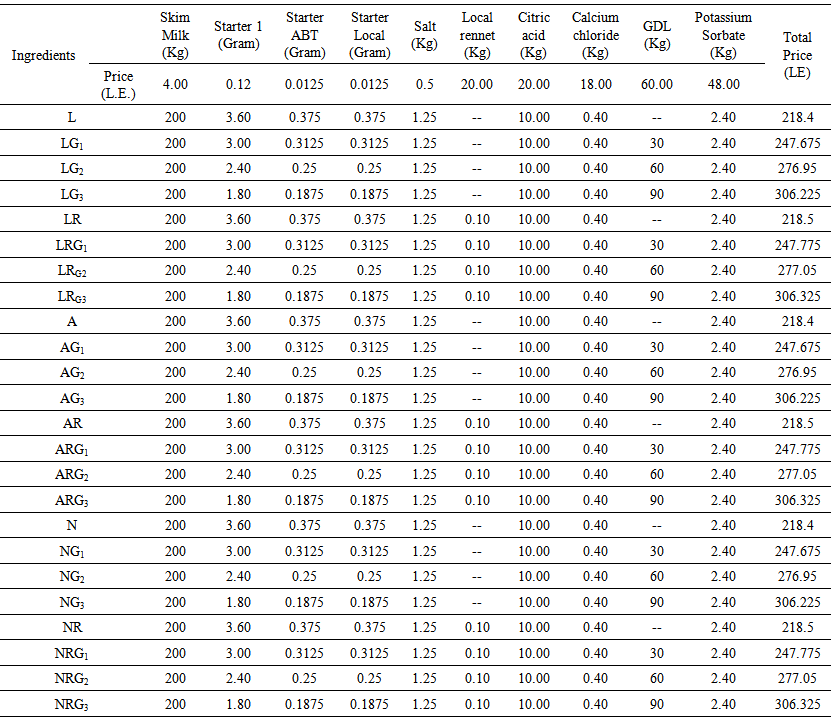
 Abstract
Abstract Reference
Reference Full-Text PDF
Full-Text PDF Full-text HTML
Full-text HTML
